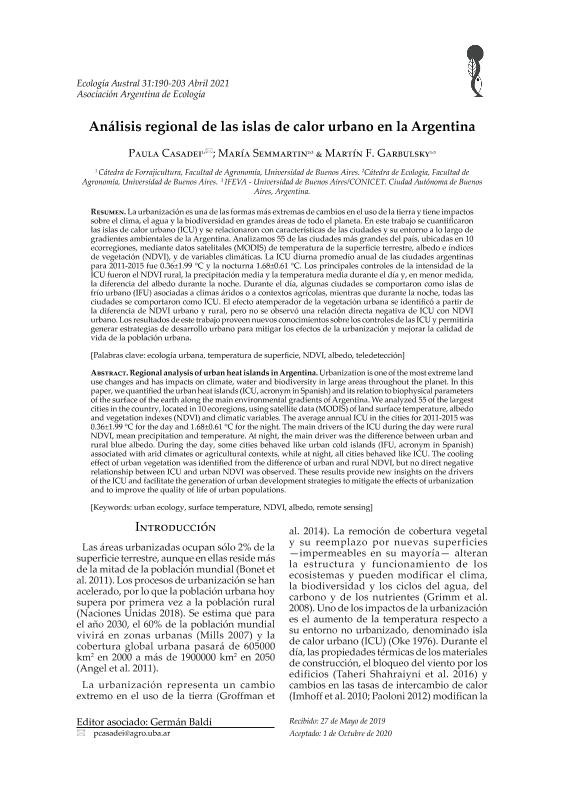Artículo
La urbanización es una de las formas más extremas de cambios en el uso de la tierra y tiene impactos sobre el clima, el agua y la biodiversidad en grandes áreas de todo el planeta. En este trabajo se cuantificaron las islas de calor urbano (ICU) y se relacionaron con características de las ciudades y su entorno a lo largo de gradientes ambientales de la Argentina. Analizamos 55 de las ciudades más grandes del país, ubicadas en 10 ecorregiones, mediante datos satelitales (MODIS) de temperatura de la superficie terrestre, albedo e índices de vegetación (NDVI), y de variables climáticas. La ICU diurna promedio anual de las ciudades argentinas para 2011-2015 fue 0.36±1.99 °C y la nocturna 1.68±0.61 °C. Los principales controles de la intensidad de la ICU fueron el NDVI rural, la precipitación media y la temperatura media durante el día y, en menor medida, la diferencia del albedo durante la noche. Durante el día, algunas ciudades se comportaron como islas de frío urbano (IFU) asociadas a climas áridos o a contextos agrícolas, mientras que durante la noche, todas las ciudades se comportaron como ICU. El efecto atemperador de la vegetación urbana se identificó a partir de la diferencia de NDVI urbano y rural, pero no se observó una relación directa negativa de ICU con NDVI urbano. Los resultados de este trabajo proveen nuevos conocimientos sobre los controles de las ICU y permitiría generar estrategias de desarrollo urbano para mitigar los efectos de la urbanización y mejorar la calidad de vida de la población urbana. Urbanization is one of the most extreme land use changes and has impacts on climate, water and biodiversity in large areas throughout the planet. In this paper, we quantified the urban heat islands (ICU, acronym in Spanish) and its relation to biophysical parameters of the surface of the earth along the main environmental gradients of Argentina. We analyzed 55 of the largest cities in the country, located in 10 ecoregions, using satellite data (MODIS) of land surface temperature, albedo and vegetation indexes (NDVI) and climatic variables. The average annual ICU in the cities for 2011-2015 was 0.36±1.99 °C for the day and 1.68±0.61 °C for the night. The main drivers of the ICU during the day were rural NDVI, mean precipitation and temperature. At night, the main driver was the difference between urban and rural blue albedo. During the day, some cities behaved like urban cold islands (IFU, acronym in Spanish) associated with arid climates or agricultural contexts, while at night, all cities behaved like ICU. The cooling effect of urban vegetation was identified from the difference of urban and rural NDVI, but no direct negative relationship between ICU and urban NDVI was observed. These results provide new insights on the drivers of the ICU and facilitate the generation of urban development strategies to mitigate the effects of urbanization and to improve the quality of life of urban populations.
Análisis regional de las islas de calor urbano en la Argentina
Título:
Regional analysis of urban heat islands in Argentina
Fecha de publicación:
19/02/2021
Editorial:
Asociación Argentina de Ecología
Revista:
Ecología Austral
ISSN:
1667-7838
e-ISSN:
0327-5477
Idioma:
Español
Tipo de recurso:
Artículo publicado
Clasificación temática:
Resumen
Palabras clave:
ISLA DE CALOR
,
ECOLOGÍA URBANA
,
CAMBIO CLIMÁTICO
,
CALENTAMIENTO GLOBAL
Archivos asociados
Licencia
Identificadores
Colecciones
Articulos(IFEVA)
Articulos de INST.D/INV.FISIOLOGICAS Y ECO.VINCULADAS A L/AGRIC
Articulos de INST.D/INV.FISIOLOGICAS Y ECO.VINCULADAS A L/AGRIC
Articulos(OCA PQUE. CENTENARIO)
Articulos de OFICINA DE COORDINACION ADMINISTRATIVA PQUE. CENTENARIO
Articulos de OFICINA DE COORDINACION ADMINISTRATIVA PQUE. CENTENARIO
Citación
Casadei, Paula; Semmartin, María Gisela; Garbulsky, Martín Fabio; Análisis regional de las islas de calor urbano en la Argentina; Asociación Argentina de Ecología; Ecología Austral; 31; 19-2-2021; 190-203
Compartir




